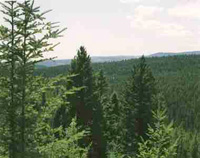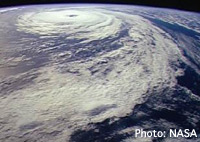
News |
- Bright Future For Green Economy
- Manitobans Urged To Vote Environment
- WCI Poses Risk to Boreal Forests
- Old Growth Forests - Vital Carbon Sinks
- Emissions Growing Four Times Faster
- Act Bans Hog Expansion
- Commission to Re-examine Nitrogen Removal
- Bird Numbers Declining Worldwide
- Manitoba Wildlands Posts Election Sources
- Bi Pole III Information Lacking
- U.S. Mercury Pollution Investigation Begins
- Being Green Starts with Blue
| Bright Future For Green Economy | 15 October 08 |
 A new report from the United Nations and The International Labour Organization examines global environmental challenges and their relation to employment. The report Green Jobs: Towards Decent work in a Sustainable, Low-Carbon World says recent efforts to fight climate change have created a shift in economic sectors. There is a demand for 'green jobs' that will reduce environmental impacts to sustainable levels. A boom is expected for 'green jobs' in renewable energies, energy efficiency in buildings, sustainable transportation, and organic agriculture. A new report from the United Nations and The International Labour Organization examines global environmental challenges and their relation to employment. The report Green Jobs: Towards Decent work in a Sustainable, Low-Carbon World says recent efforts to fight climate change have created a shift in economic sectors. There is a demand for 'green jobs' that will reduce environmental impacts to sustainable levels. A boom is expected for 'green jobs' in renewable energies, energy efficiency in buildings, sustainable transportation, and organic agriculture.Currently, renewable energy generates more jobs than fossil fuels. Employment is expected to rise to 2.1 million in wind-power and 6.3 million in solar power by 2030. A similar study released by the U.S. Conference of Mayors says renewable energy and energy efficiency are expected to produce 4.2 million jobs in the U.S. by 2038. Both wealthy and developing countries will see job creation. The report encourages governments, employers and trade unions to promote environmentally sustainable jobs. View ILO report, Green Jobs: Toward Decent Work in a Sustainable, Low-Carbon WorldView September 24, 2008 UN Environmental Programme release Visit International Labour Organization - Green Job Initiative View October 6, 2008 OneIndia article View October 1, 2008 Associated Press article Sources: International Labour Organization, UN Environmental Programme, OneIndia, Associated Press |
|
 Print version Print version |
Top |
| Manitobans Urged To Vote Environment | 09 October 08 |
 Canada's 2008 federal election will mark the 40th time Canadians have gone to the polls in our country's 141-year history. While all elections matter, some elections have more serious implications than others. Some campaigns have nation altering consequences - our 1988 election, focused on free trade, is one obvious instance of a nation altering vote. Canada's 2008 federal election will mark the 40th time Canadians have gone to the polls in our country's 141-year history. While all elections matter, some elections have more serious implications than others. Some campaigns have nation altering consequences - our 1988 election, focused on free trade, is one obvious instance of a nation altering vote. The 2008 election may be the most critical election in our history, for its outcome will have not only profound national consequences but global ones as well. Canadians are considering their environmental legacy at home and globally. They are also seeking solutions and messages of hope. This election will set the course and define Canada's approach to the climate crisis. Voters wish to elect a government that will take real action on climate change - the most important single challenge the world faces at the dawn of the twenty-first century. Five federal political parties have made their climate positions clear. "This election is so critical, each individual vote matters so much, and its vitally important we elect people and parties committed to climate change action," said Gaile Whelan Enns, of Manitoba Wildlands, a member of Climate Action Network Canada. View Manitoba Wildlands Election page, including party platforms and informationVisit VoteEnvironment.ca Visit TomorrowToday website for all party Environment & Climate Survey Source: Manitoba Wildlands |
|
 Print version Print version |
Top |
| WCI Poses Risk to Boreal Forests | 07 October 08 |
 The Canadian Parks and Wilderness Society (CPAWS) is raising the alarm, saying new rules crafted to limit greenhouse gas emissions may actually provide a perverse incentive to intensify logging in Canada's natural forests. The Canadian Parks and Wilderness Society (CPAWS) is raising the alarm, saying new rules crafted to limit greenhouse gas emissions may actually provide a perverse incentive to intensify logging in Canada's natural forests.Environmental groups have advocated for all energy emissions to count within the Western Climate Initiative (WCI) cap-and-trade program. The draft set of recommendations released July 2008 suggests emissions resulting from logging and burning natural forests to produce electricity would be ignored. The final recommendations for the regional cap-and-trade program - released September 23, 2008 -allows each province and state to decide whether to ignore these real emissions and treat them as carbon neutral. The argument for carbon neutrality of these emissions is that producing bioenergy from forests does not increase emissions because trees grow back and remove carbon back out of atmosphere as they grow. "The problem is that it can take more than a hundred years for a natural forest to take the carbon back from the atmosphere, if it ever does. In the meantime, switching to woody bioenergy actually increases emissions in the short-term when reductions are most urgently needed," says Chris Henschel, expert on forests and climate change for CPAWS. CPAWS contends WCI governments need to send a clear signal that they will not create a perverse incentive to log and burn natural forests with no actual climate benefit. Creating a market to burn natural forests for electricity could result in much greater pressures to log these forests and accelerate clear cutting of northern pristine boreal forests. View September 24, 2008 Canadian Parks and Wilderness Society press releaseView September 23, 2008 Western Climate Initiative press release (PDF) View Manitoba Wildlands' Western Climate Initiative webpage Source: Canadian Parks and Wilderness Society |
|
 Print version Print version |
Top |
| Old Growth Forests - Vital Carbon Sinks | 07 October 08 |
 New analysis suggests that old growth forests act as 'carbon sinks'. Preserving the world's shrinking ancient and intact forests can offset greenhouse gas emissions. New analysis suggests that old growth forests act as 'carbon sinks'. Preserving the world's shrinking ancient and intact forests can offset greenhouse gas emissions.A new international study published in the journal Nature found that about 15 percent of forested land in the Northern Hemisphere is unmanaged primary forests with large amounts of old growth. These stands may account for 10 percent of the global net uptake of carbon dioxide. The report's author, Sebastiaan Luyssaert of the University of Antwerp, Belgium, and his colleagues, analyzed years of FLUXNET data, a global network of observatory towers that measure the exchanges between forest ecosystems and the atmosphere. New findings dispute claims that forests give off as much CO2 as they take up. Old growth forests both under tenure and not yet under tenure was not included in the Kyoto Protocol. These forests should be taken into account in the global carbon balance assessments, and in negotiations for the post 2012 Global Climate Agreement. View September 2008 Nature, Old-growth forests as global carbon sinks (PDF)View September 25, 2008 Science Daily article View September 10, 2008 Nature article View September 14, 2008 Science Daily article View September 11, 2008 Scientific American article View September 30, 2008 Deccan Herald article View September 16, 2008 EurActiv.com article Sources: Science Daily, Nature, Scientific American, Deccan Herald, EurActiv.com |
|
 Print version Print version |
Top |
| Emissions Growing Four Times Faster | 07 October 08 |
 New global carbon budget figures reveal emissions are rising rapidly. Greenhouse gases from fossil fuels and the cement industry have increased by 3.5 percent per year from 2000 to 2007. New global carbon budget figures reveal emissions are rising rapidly. Greenhouse gases from fossil fuels and the cement industry have increased by 3.5 percent per year from 2000 to 2007.The Global Carbon Project, a joint international project on the global carbon cycle reports China is now the world's biggest polluter, accounting for 60 percent of all growth in emissions. Currently, more than half of global emissions come from less developed or developing countries. The authors of the report said the efficiency of oceans, forests and other carbon dioxide 'sinks' in removing CO2 has decreased over the past 50 years. The rapid rise in emissions so far this decade is unprecedented and disastrous changes to the climate may be unavoidable. GHG emissions from wealthy nations dipped in 2006, the first time in five years. A Reuters survey of industrialized nations indicates emissions fell to the equivalent of 18.01 billion tonnes of carbon dioxide from 18.03 billion in 2005. Rising oil prices are seen as a factor. View Global Carbon Project (2008) Carbon budget and trends 2007Visit The Global Carbon Project View September 25, 2008 Global Carbon Project release (PDF) View October 6, 2008 Pollution Online article View September 29, 2008 PlanetArk article View September 26, 2008 Telegraph article View September 26, 2008 New York Times article View September 26, 2008 San Francisco Gate article View September 25, 2008 Wall Street Journal Blog entry Sources: The Global Carbon Project, The Telegraph UK, San Francisco Gate |
|
 Print version Print version |
Top |
| Act Bans Hog Expansion | 03 October 08 |
 Manitoba has passed Bill 17, an amendment to the Environment Act, halting unsustainable growth for the hog industry in three regions of the province, an estimated 6.5 million acres of land. The bill provides a permanent ban against new or expanding hog barns. Bill 17 roused passionate presentations at Manitoba Legislature during spring and summer 2008, during legislative review hearings. Manitoba has passed Bill 17, an amendment to the Environment Act, halting unsustainable growth for the hog industry in three regions of the province, an estimated 6.5 million acres of land. The bill provides a permanent ban against new or expanding hog barns. Bill 17 roused passionate presentations at Manitoba Legislature during spring and summer 2008, during legislative review hearings.Bill 17 will restrict hog operations in the intensively developed Southeastern Manitoba region, the Red River Valley, which is high-risk area for flooding, and the Interlake region that borders two lakes. Hog producers and opposition critics argue the bill is pitting urban residences against rural food producers. Protesting producers said the bill will hurt Manitoba, kill jobs and have little benefit for Lake Winnipeg. The hog industry across Canada is currently being impacted by several external factors. View September 24, 2008 Government of Manitoba press releaseView Bill 17, Environment Amendment Act (Permanent ban on building or expanding hog facilities) View September 24, 2008 Canadian Press article View September 26, 2008 Grain News article View September 24, 2008 Winnipeg Free Press article View September 25, 2008 Winnipeg Sun article View September 26, 2008 Pig Progress article Source: Government of Manitoba, Grain News, Winnipeg Free Press, Winnipeg Sun, Pig Progress, Canadian Press |
|
 Print version Print version |
Top |
| Commission to Re-examine Nitrogen Removal | 01 October 08 |
 The Manitoba government has requested its Clean Environment Commission (CEC) to take a second look at nitrogen removal from wastewater in light of compelling evidence it is unnecessary. The Manitoba government has requested its Clean Environment Commission (CEC) to take a second look at nitrogen removal from wastewater in light of compelling evidence it is unnecessary.In 2003 the CEC ordered the province of Manitoba to ensure Winnipeg's wastewater treatment system would remove both nitrogen and phosphorus to improve water quality. Recent scientific and political statements have opposed nitrogen removal, saying phosphorus is the main case of harmful blooms of potentially deadly blue-green algae. The Manitoba government is investing $235 million to upgrade three water treatment plants in Winnipeg. Current estimates suggest that 10 to 15 percent of these upgrade costs are for nitrogen removal. As of September 30, 2008 the formal reference from the government asking the CEC to conduct an investigation was not available. View September 17, 2008 Manitoba government press releaseView September 17, 2008 CJOB article View July 23, 2008 Winnipeg Free Press article View September 24, 2008 EcoLog article View August 20, 2008 Manitoba Wildlands news item Sources: Government of Manitoba, Winnipeg Free Press, CJOB68, Ecolog, Manitoba Wildlands |
|
 Print version Print version |
Top |
| Bird Numbers Declining Worldwide | 01 October 08 |
 Bird populations are experiencing dramatic declines worldwide. Conservationists say the trend is an accurate indicator of the state of our environment and the pressures we are putting on the world's biodiversity. Bird populations are experiencing dramatic declines worldwide. Conservationists say the trend is an accurate indicator of the state of our environment and the pressures we are putting on the world's biodiversity. Birdlife International released a report, The State of the World's Birds. Their report indicates that in North America over the last 40 years, there has been a decline of more than 50 percent in populations of 20 of the most common birds. Deterioration of bird populations is accelerating - one in eight of 9,856 living bird species are thought to be in trouble. Of these, 190 face imminent risk of extinction. The exact cause of bird declines is unknown but environmental degradation, land-use changes, monoculture plantations, fishing, and logging are all serious threats. Conservationists have identified about 10,000 places in the world that provide critical habitats for birds, of these 600 are in Canada. This Canadian inventory is far from complete but most are located in southern regions of Canada and impacted by human development. View State of the World's Birds 2008 report (PDF)Visit Bird Life International View September 23, 2008 Globe and Mail article View September 22, 2008 BBC News article View September 22, 2008 The Greenpages article View September 23, 2008 Reuters article View September 22, 2008 UK Telegraph article Sources: Globe and Mail, BBC News, The Green Pages, Reuters, Telegraph UK |
|
 Print version Print version |
Top |
| Manitoba Wildlands Posts Election Sources | 26 September 08 |
 During the Canadian federal election Manitoba Wildlands is posting sets of citizen resources, election web sites, and other materials. These all pertain to environmental and climate related issues and information. During the Canadian federal election Manitoba Wildlands is posting sets of citizen resources, election web sites, and other materials. These all pertain to environmental and climate related issues and information.Gaile Whelan Enns told Manitoba Wildlands, "This federal election has more environment content in parties' campaigns and news coverage than has ever happened before. Canadians' concerns for the future, for their natural world legacy, and responsibility to the rest of the world as a northern developed country are growing. Voters have an opportunity to choose where their vote will do the most for the environment. Examples include: Climate Action Network Canada's election blog, the joint KyotoPlus campaign directed to citizens and candidates in the election, plus the VoteForEnvironment.ca web site which provides information on party standings in federal ridings where the election is close. Each political party is also linked so access to their election platforms and other materials can easily be found by Canadians/ Manitobans seeking environmental and climate election announcements. View Manitoba Wildlands' 2008 Federal Election Resources pageView Harris/Decima Election polling website View VoteForEnvironment.ca Sources: Manitoba Wildlands |
|
 Print version Print version |
Top |
| Bi Pole III Information Lacking | 26 September 08 |
 Manitoba Hydro, despite, usually holding downtown Winnipeg open houses for its projects, has decided that there will be no central Winnipeg open house. Manitoba Hydro, despite, usually holding downtown Winnipeg open houses for its projects, has decided that there will be no central Winnipeg open house.Environmental Statements are not available for Bi Pole III standards. There is no indication what Environmental Assessment standards Bipole III would be held to. No timetable has been made ready for the public environmental reviews, or for any of the stages of the licensing process. The options under discussion are only possible corridor options. One open house in St. Norbert at the far south end of Winnipeg is not sufficient access for Winnipeggers. Winnipeg comprises 2/3 of Manitoba's population and a relevant level of public discussion and involvement is necessary for Manitoba Hydro to ethically conduct public consultation. "Can we trust Manitoba Hydro's version of the outcomes from these open houses," says Gaile Whelan-Enns of Manitoba Wildlands, "when Manitoba Hydro seems to be going out of its way to keep Winnipeggers from participating?" Little information regarding Bi Pole III is public. While the routing study is provided on their web site, Manitoba Hydro has not posted any of the information provided in the public open houses. View Manitoba Hydro Bipole III webpagesView 2007 Manitoba Hydro Bipole III transmission study report (PDF) Sources: Manitoba Hydro, Manitoba Wildlands |
|
 Print version Print version |
Top |
| U.S. Mercury Pollution Investigation Begins | 17 September 08 |
 The Secretariat of the Commission for Environmental Cooperation (CEC) released a work plan to develop a factual record of Untied States coal-fired power plants. The investigation began August 29, 2008. The Secretariat of the Commission for Environmental Cooperation (CEC) released a work plan to develop a factual record of Untied States coal-fired power plants. The investigation began August 29, 2008.The investigation comes years after a September 2004 petition was filed with the CEC by Ecojustice and Waterkeeper Alliance, representing a number of NGOs. It claimed the US Environmental Protection Agency failed to enforce the Clean Water Act (CWA), leading to mercury pollution in water bodies by coal fired power plants. The investigation to gather facts from NGOs, government and technical sources will examine permits for forty coal fired plants in ten US states. CEC will also look into Total Maximum Daily Load (TMDL) calculations. A draft factual record will be prepared by June 2009 and shed light on whether the EPA allowed for ongoing point source discharges of mercury into US waterways and neglected to account for mercury that falls back to earth from coal power air emissions. View September 5, 2008 CEC articleView Ecojustice Petition View CEC, Overall Plan to Develop a Factual Record(PDF) View June 23, 2008 CEC Council Resolution 08-03 (PDF) View CEC Request for Information for Preparation of a Factual Record (PDF) View Citizen Submission on Enforcement Matters: Summary of Coal-fired Power Plants Submission & Response View July 8, 2008 Manitoba Wildlands news item Sources: CEC, Ecojustice, Manitoba Wildlands |
|
 Print version Print version |
Top |
| Being Green Starts with Blue | 16 September 08 |
 The UN estimates that 5.5 billion people will lack adequate access to freshwater in the next 20 years. A non-profit organization is addressing this serious problem head on through educational stories on emerging problems and solutions to water issues. The UN estimates that 5.5 billion people will lack adequate access to freshwater in the next 20 years. A non-profit organization is addressing this serious problem head on through educational stories on emerging problems and solutions to water issues.The Circle of Blue is an innovative global network of journalists, data experts, scientists, and communications designers. They see creating awareness of fresh water's affect on our health, world poverty, economy and climate as the first step toward action. Researchers gather information from around the world and translate it into meaningful, visual and accessible forms. Circle of Blue is working toward a major global survey on water issues to create baseline data and to identify gaps in information. Their newest initiative, the "Aspen Design Challenge" is an effort to re-examine how we look at water. Students from over 250 universities are invited to develop design solutions that encourage responsible water use, provide access to freshwater and increase awareness about the importance of water conservation. Visit Circle of Blue websiteView September 4, 2008 CSR Wire article View August 27, 2008 Inhabitat article View August 19, 2008 Design Taxi article Sources: Circle of Blue, Corporate Social Responsibility News, Inhabitat, Design Taxi |
|
 Print version Print version |
Top |


 RSS Feeds:
RSS Feeds: